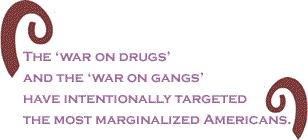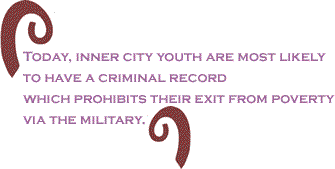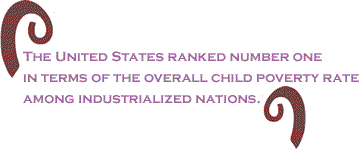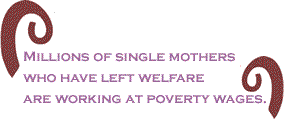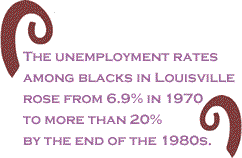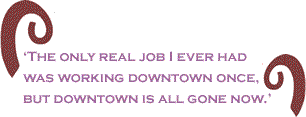
|
|||||||||||||||||||||
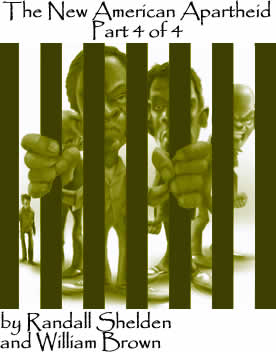 |
The Impact on Black Families and Communities Although precise data are hard to come by, we can easily infer from the discussion in the first three parts of this series that recent developments have had a negative impact on black communities in general and families in particular. The inner-cities of America have been the most negatively affected by these changes. The movement of capital out of the inner cities (“capital flight”) corresponded to the phenomenon of "white flight" and the exodus of many middle class minorities, the decline of the tax base for these areas and the increasing concentration of the poor who were left behind. There has also been a corresponding decline in federal funding for social programs, particularly those targeting the urban underclass. This largely occurred during the 1980s with the dawn of a "privatization" movement, a system aiming to replace federal assistance with private sector methods of solving urban problems. Among the specific types of programs that suffered included aid to disadvantaged school districts, housing assistance, financial aid to the poor, legal assistance to the poor and social services in urban areas in general. There has been a marked decline in job opportunities, especially for minorities. Many jobs have shifted to the suburbs, as have many basic services and the tax base as well. It used to be common for many minority youth to be able to find unskilled and semi-skilled jobs. Today these jobs are disappearing and being replaced by either low-wage service jobs or high-wage jobs requiring advanced skills and education. In the 1960s and early 1970s, inner city youth were targeted for induction into military service. This was viewed by many as a means to escape a life of poverty. Today, inner city youth are most likely to have a criminal record which prohibits their exit from poverty via the military. A closely related development has been described
as the feminization
of poverty. This refers to the increase in female-headed households
that are most likely to be living in poverty. This has been especially
true for black women for, according to the 2000 census, 48% of
all black families are
The National Women’s Law Center recently reported that: “While the proportion of female-headed families living in poverty declined between 1997 and 1998 and is now at its lowest since 1979, nearly 4 out of 10 families headed by women still live in poverty.” They further observed that as of 1998, among families with children headed by a black woman, 47.5 percent were living in poverty, while more than half of the female-headed Latino families with children lived under the poverty line. A recent study by the National Center for Children in Poverty found that: “More than one-third of children in the United States live in low-income families, meaning their parents earn up to double what is considered poverty in this country. The federal poverty level for a family of four (2004) is $18,850.” The study also found that:
With regard to race, the NCCP study also found that: “While the largest group of children in low-income families is white, black and Latino children are significantly more likely to live in families with low incomes, and they account for the increase in low-income children.” (“Low-income” is defined in this report as twice the official federal poverty level, or $37,700 for a family of four.) Further, 58 percent of all black children (up 4% from 2001) and 62 percent of all Latino children (up 1% from 2001), compared to only 25 percent of white children, lived in low-income families in 2002 (down 2% from 2001). (See the following web site: www.nccp.org.).
The "welfare reform" movement ushered in during the Clinton Administration in 1996 significantly reduced the number of citizens on the welfare rolls. Specifically, as of 1999 about 7 million were receiving welfare, compared to just over 12 million in 1996. There has been a negative impact, however, as millions of single mothers who have left welfare are working at poverty wages. One study found that the average wage of these mothers was $6.60 per hour. More than one-fourth of these mothers were working nights, while two-thirds have jobs without health insurance. Also, more than half of them are having trouble getting decent and affordable child care and paying for such necessities as food and rent. Still another report noted that whites were leaving welfare at a much faster pace than minorities. One example was in Ohio, where in 1995 just over half of the welfare recipients (54%) were white and 42% were black, by 1999 theses percentages were reversed: 53% black and 42% white. Research has also shown that it has been much easier to leave welfare for those living away from the inner cities, which obviously helps whites since they are most likely to live in the suburbs. According to a 1999 study conducted by The Center on Budget and Policy Priorities, between 1995 and 1997 the income of the poorest 20 percent of female-headed families with children decreased by an average of $580 per family. Even when various “benefits” (e.g., food stamps, housing subsidies, the Earned Income Tax Credit) are included, these families have incomes well below three-quarters the “official” poverty line (which, as many critics have pointed out, is dated and in need of revision). Studies have also found that single mothers on welfare rarely find full-time, permanent jobs at good wages. While recent welfare legislation has focused on child support enforcement, full payment of child support only constitutes a small portion of the total cost of raising a child.
The study also found that about 39 percent of female-headed households with children were living in poverty. The report further noted that about 1.3 million more people were poor in 2001 than in 2000 -- 32.9 million versus 31.6 million. The number of poor families increased from 6.4 million in 2000 (or 8.7 percent of all families, a record low rate) to 6.8 million (or 9.2 percent) in 2001. For whites the poverty rate rose from 7.4 percent in 2000 to 7.8 percent in 2001, but poverty “remained at historic lows for blacks (22.7 percent) and Latinos (21.4 percent).” Among these groups, only “whites (up 905,000 to 15.3 million) and Latinos (up 250,000 to 8.0 million) saw an increase in the number of poor.” The declining social and economic position of blacks, especially as this relates to young black males whom one author has called an "endangered species," is significant. The impact on one particular city, Louisville, was described by two criminologists who noted that the underclass in this city is "comprised largely of minorities who are increasingly marginal to the city's economy. The neighborhoods populated by the underclass are characterized by high rates of crime, institutional instability, and impoverished households headed by females. Louisville's new urban poverty is exacerbated by severe dislocations in the manufacturing and industrial sectors of its regional economy." The unemployment rates among blacks in Louisville rose from 6.9% in 1970 to more than 20% by the end of the 1980s. Also, in 1970 45% of births by black women were out of wedlock, whereas in 1988 the percentage was 70. It is not very difficult to lay part of the blame on the devastation of poor, black communities on the shoulders of the criminal justice system and those who design the policies. A recent study by one of the co-authors (William Brown) of this series underscores this point. Brown interviewed some of the families of gang members in Detroit to identify some of the effects of not only participation in gang life, but the impact on the family when a gang member goes to prison. All of these families are black, mostly poor (including many among the working poor).
The families in Brown’s study had no "material" luxuries. One father of four, wearing the scars of rejection and humiliation, stated:
Holding his wife's hand (she works in a laundry for minimum wages), he looked up and said, "Me and this old woman is about wore down now." His wife in an attempt to lighten the subject and offer inspiration for her husband, said, "When they build that new stadium [Detroit Tigers' baseball stadium] here you can make some money then.” Well," he replied, "they is just going to hire us niggers for the laboring jobs, so don't go counting on that new stadium to help us none." The father of another gang member has two full-time, minimum-wage, jobs. His wife works part-time. They have three children. "I've tried to get me a full-time job," she stated, "but they ain't none around here. We only got one car, and he's [the husband] got to use it because his other job is a long way from the shop."
One mother of four, whose husband had abandoned her and the children several years earlier, lives in a deteriorating two-bedroom apartment with an inefficient heating system. During one visit, Brown heard gun shots very close by, and quickly moved his head toward the window. Obviously accustomed to the sound, she never moved. They began talking about the subject of "hope." This woman revealed:
Thus, there is a sense of resignation, and a feeling that her life could be worse. When asked why she never left the neighborhood, she answered:
Ten gang members live in households where a grandparent is the primary breadwinner. In eight of these cases, most of the family income comes from social security and/or very modest retirement benefits. Rather than the elderly being assisted by their children, many grandparents find themselves in a position where they must raise a second family. One elderly woman, who has lived in the same neighborhood for more than 40 years, shares her two-bedroom house with her daughter-in-law, three grandchildren, and "boots," the family feline. Rags are stuffed around the windows to fill gaps that run her heating bill "through the ceiling." The middle step leading to the front door is broken. She leans back in an overstuffed chair, once belonging to her husband who died more than ten years ago, and started to talk about her "boys" who are both in prison.
 Bobby, who once was a member of a gang in this neighborhood, was prosecuted and convicted on auto theft and drug charges. He received 5 years and 15 years (consecutive) sentences. The woman was asked about her husband and she responded as follows:
All adult family members Brown interviewed expressed concern about their children's, or grandchildren's, involvement in youth gangs. Most attempted to control their children's activities. "I tell him all the time to stay away from them kind of kids," says one mother. A father stated, "I don't like him running wild out there, but we [including his wife] both got jobs. We just can't watch him all the time. One father admitted, "I beat the hell out of him when I found out he was banging. But he keeps right on doing it. I can't just keep beating him – then they'll come and arrest me." Another father stated, "I try to tell him that he's going to end up dead or in prison some day. He just won't listen. I want him to get a job, but there ain't none around. I'm lucky to be working myself." Some Concluding Thoughts
We live in times of great uncertainty as millions just barely eke out a living while a small minority becomes richer and richer, despite proclamations from politicians and the media about the "economic recovery" and the booming stock market. We find more and more of our citizens relegated to the ranks of what Marx once described as the "surplus population," a population rendered unneeded or "superfluous" as far as creating profits are concerned. Along with more and more corporate "downsizing" there is the ominous disappearance of semi-skilled and unskilled jobs once filled by urban minorities, especially black males. But this group is still very much with us and, from the point of view of those in power, they need to be "managed" in some way. One way that has been used to manage or control this population is to confine them to inner city ghettos, while another way is to use the prison system as a mechanism of this form of "management." It is especially ironic that we are experiencing what politicians are calling the "end of welfare as we know it." This is true. We previously had a welfare system that patronized the poor; we now have a welfare system that can be described in a single word: mean. The irony is that a component of this new form of welfare is called the prison system. And since there has not been a significant rise in the kinds of crimes that have historically resulted in prison sentences (burglaries, larcenies, robberies, murder, etc.), and we cannot use the crude techniques of control common in totalitarian societies (e.g., torture), we have invented new "crimes" and new "criminals" to justify prison expansion, namely drugs. But of course only certain kinds of drugs, used by certain classes of people are targeted. More and more women are finding themselves completely left out of the recent "economic upturn" American society has experienced. Like earlier generations, minority women have suffered the most, as they find themselves mired in poverty with the sole responsibility of child rearing. Even among women who are working, times are getting harder and harder. Given the continuous "war on drugs" along with efforts to "end welfare as we know it," women, especially minority women, are going to continue to experience being processed by the criminal justice system. The "war on drugs" and the "war on gangs" have intentionally targeted the most marginalized Americans. Is this not also a form of slow genocide and a disenfranchisement of urban minorities and a form of "ethnic cleansing"? Have we not created a new, more modern form of apartheid? To do this it is necessary to use certain scientific-sounding labels, like "sociopath" or "criminal personality." Of course the traditional, gut-level terms are also used, like "dangerous classes," "predators," "thugs," "gangs" and the like. It is not "our kind" that are being sent to prison, it is "them," "those people," etc. This way we can wash our hands of any responsibility. Click here to read Part 1 of this series Click here to read Part 2 of this series Click here to read Part 3 of this series. Randall G. Shelden and William B. Brown are Professors of Criminal Justice at the University of Nevada-Las Vegas and Western Oregon University respectively. They have written several books on crime and criminal justice. This essay is part of a forthcoming book on the prison industrial complex. Shelden may be contacted via his web site: http://www.sheldensays.com. A more detailed version of this series, including references and footnotes, can be found on this web site. |
July
29 2004 |
|||||||||
|
|||||||||
|
|
|||||||||
| Printer Friendly Version | |||||||||
 |
|||||||||
| |
|||||||||
| |
|||||||||





















